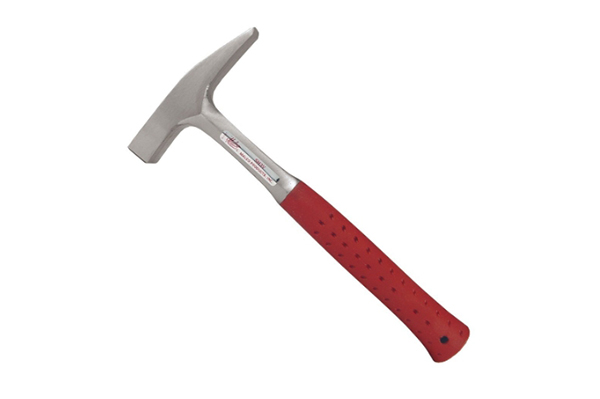This article dives deep into the world of the riveting hammer, exploring its design, how to use it effectively, and why it remains an indispensable tool for various industries. Whether you're a seasoned tradesperson or a DIY enthusiast, understanding the nuances of the riveting hammer can significantly enhance your work and the quality of your projects. We’ll cover everything from the hammer’s construction and make to the various applications where it shines, offering insights that will help you choose the right one and use it like a pro. This guide is worth reading because mastering the riveting hammer opens up a world of possibilities for joining metal components securely and efficiently.
1. What is a Riveting Hammer, and Why is it Important?
A riveting hammer is a specialized hammer designed for driving rivets, which are permanent mechanical fasteners. Unlike a standard hammer, the riveting hammer often has a head specifically designed for shaping the rivet head and setting the rivet securely. It's a critical tool in industries where strong, durable, and tamper-proof joints are required. Think of it as the tool of choice when rivets are your connection of choice.
[ ]
]
The importance of the riveting hammer come from the rivet itself. A rivet make a permanent bond, often stronger and more reliable than other joining methods like screws, especially in high-stress applications. The hammer's role is to deform the rivet material, creating a head on the rivet's end, effectively clamping the materials together. This process is crucial for ensuring the structural integrity of various products, from aircraft to metal furniture.
2. Riveting Hammer Design: What Makes it Special?
The design of a riveting hammer is what sets it apart from other hammers. Most riveting hammers come with two key features: a flat face for striking the rivet head and a peen, which is often ball-shaped or cross peen, for shaping the rivet head. The head is typically made from hardened steel to withstand repeated impacts.
The flat face is used to initially set the rivet and drive it through the sheet metal or other materials. The peen is then used to form the rivet's head, either by mushrooming it out for a solid bond or by creating a countersunk head for a flush finish. The design of the handle is also important; it should offer a comfortable grip and a balanced feel for efficient work. The balance allows for the light touch, so you can use a riveting hammer all day long.
Another critical aspect of the design is the weight and size. The size will impact how much force is needed to successfully set the rivet. A lightweight riveting hammer is easier to maneuver, especially in small spaces. But a hammer that’s too light won’t be as effective for setting larger rivets. A well-designed riveting hammer will have the correct weight to match the required work and the desired precision. This is one of the most common reasons for using a riveting hammer, as precision is key.
3. Types of Riveting Hammers: Which One Do You Need?
Riveting hammers come in several types, each suited for different rivet types and applications. The most common are flat-face hammers and ball-peen hammers. Flat-face hammers are ideal for general riveting and for initial setting of the rivet. Ball-peen hammers, with their rounded peen, are particularly useful for shaping the rivet head and peening operations.
Other types include cross-peen hammers, which have a peen that's designed to move the metal in a specific direction, and small hammers with flat faces. These are good for areas where there is a need to apply a more specific stroke, like inside of a tight angle. The best choice depends on the size and type of rivets you'll be useing and the desired finish. The size of the peen also matters, because the size affects the type of work that you make.
4. Choosing the Right Size Riveting Hammer for the Job
Selecting the correct size riveting hammer is essential for achieving the best results and preventing damage to the rivet or the surrounding materials. The size typically refers to the weight of the hammer, which influences the force applied during setting. A small, light riveting hammer is typically adequate for small rivets in delicate applications, while larger, heavier hammers are needed for larger rivets or thicker materials. The size depends on the rivet.
Consider the size of the rivet, the material being joined, and the desired finish when choosing a riveting hammer. A hammer that's too light won't set the rivet properly, leading to a weak joint. One that's too heavy can deform the rivet excessively or damage the surrounding material. This is why people make a riveting hammer a main tool in their shop, and for the best work there is a need for a good tool. The right size is determined by experience, which is why a small set of riveting hammers is essential.
5. Essential Techniques: How to Use a Riveting Hammer Effectively
Proper technique is just as important as having the right tool. Begin by ensuring the materials are properly aligned and the rivet is correctly inserted. Place the flat face of the hammer directly on the rivet head and strike with a firm, controlled blow. Remember, the rivet head is where the most force is placed.
For forming the rivet head, use the peen to shape the metal gradually. Start with a light tapping motion, and gradually increase the force as the rivet head begins to make its shape. Avoid striking the rivet at an angle, which can bend or damage it. The goal is to make a solid, mushroomed head that securely clamps the materials together. The quality of the work will depend on this.
6. Make Your Work Easier: Ergonomics and Riveting Hammer Design
Ergonomics play a significant role in how comfortable a riveting hammer is to use, and how effective it will be. Look for hammers with ergonomic handles that are designed to fit comfortably in your hand and reduce strain during prolonged use. A well-designed handle will provide a secure grip, absorb shock, and reduce fatigue.
Material choice is also important. Handles made from hickory or fiberglass are popular choices, known for their durability and shock absorption properties. The weight and balance of the hammer should feel natural in your hand, allowing for precise and controlled strikes. This is an advantage if you are doing a lot of work, and will make the experience that much better.
7. From Aerospace to Automotive: Applications of the Riveting Hammer
The riveting hammer finds application in a wide variety of industries. In aerospace, it's used to join metal components in aircraft frames and structures, where strength and reliability are critical. In automotive manufacturing, it's used for assembling vehicle bodies, chassis, and other components. The riveting hammer is a good tool in construction.
Beyond these core industries, the riveting hammer is essential for metalworking, sheet metal work, and even in areas like furniture manufacturing. Its versatility and ability to create strong, durable joints make it a valuable tool for both industrial and small-scale projects. It is the tool that will make the best work.
8. The Importance of Precision: Achieving Professional Results
Precision is paramount when useing a riveting hammer. Accurate placement of the rivets, controlled striking force, and consistent shaping of the rivet head are all essential for achieving professional results. Poor technique can lead to weak joints, material damage, and an overall unsatisfactory finish.
Always ensure the materials are correctly aligned before setting the rivet. Use a bucking bar or support tool to provide a firm backing for the rivet during the hammering process. Careful attention to detail and a practiced technique will allow you to make joints that are not only strong but also visually appealing.
"A skilled craftsman understands the importance of precision; it separates a good job from a great one."
9. Caring for Your Riveting Hammer: Maintenance and Longevity
Proper care and maintenance can significantly extend the lifespan of your riveting hammer. After each use, clean the head to remove any debris or metal shavings. Inspect the handle for any signs of wear or damage and replace it if necessary.
Store your riveting hammer in a dry place to prevent rust and corrosion. Applying a light coat of oil to the head can also help protect it from the elements. By following these simple maintenance tips, you can ensure your riveting hammer remains a reliable tool for years to come. The care is similar to taking care of any hammer.
10. Where to Find the Best Riveting Hammers: A Buyer's Guide
When shopping for a riveting hammer, consider several factors, including the type, size, material, and intended use. Find a reputable supplier that offers high-quality hammers and accessories, and read reviews from other customers.
Check for certifications or standards compliance, especially if you’re purchasing for professional use. Compare prices and consider the overall value, not just the initial cost. Look for shops or suppliers near you if you want the fastest delivery. Consider the weight of the hammer and if it is lightweight enough for the job. This is why people often find their riveting hammer online.
Key Takeaways:
- The riveting hammer is a specialized tool designed for setting rivets, crucial for creating strong and durable joints.
- The design of a riveting hammer includes a flat face and often a peen, and its size impacts the force applied during work.
- Choose the right type and size of riveting hammer depending on the rivet type, material, and desired finish.
- Practice proper techniques, including correct alignment, controlled striking, and gradual shaping of the rivet head.
- Prioritize ergonomics and maintain your riveting hammer for optimal performance and longevity.
If you are looking for other tools, we offer a large selection of hammers and axes. Check out our selection of Engineer Machinist Strike Club Hammer Wooden Handle for a versatile hammer. Also, for high-quality products, you can find Hot Sale Octagonal Hammer Stoning Sledge Hammer Shockproof Steel Octagonal Hammer to help in the construction phase. Finally, you can browse our Metal hand tools roofing straight claw hammer with wooden handle to make sure you have all your needs.
Post time: 02-18-2025





